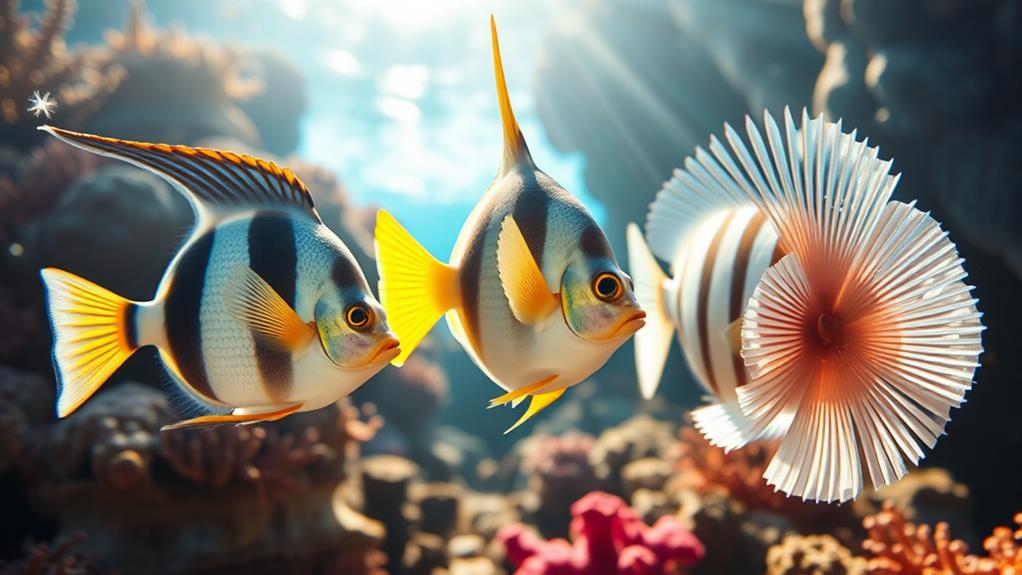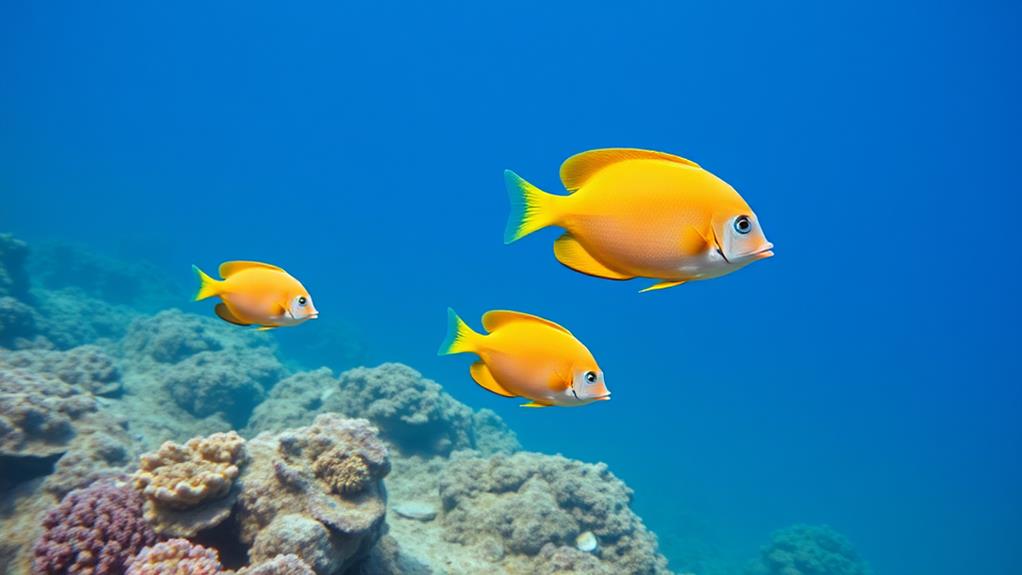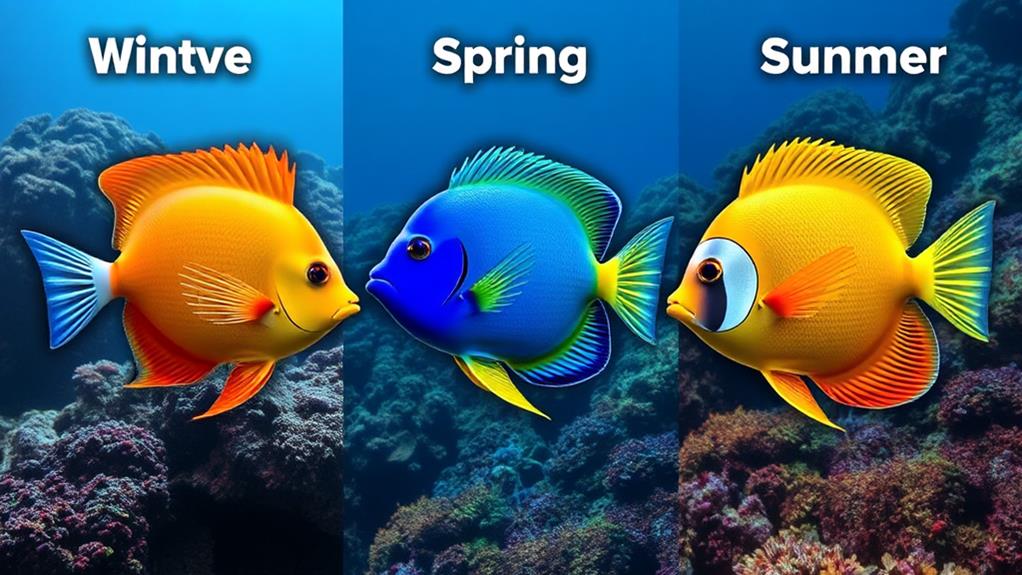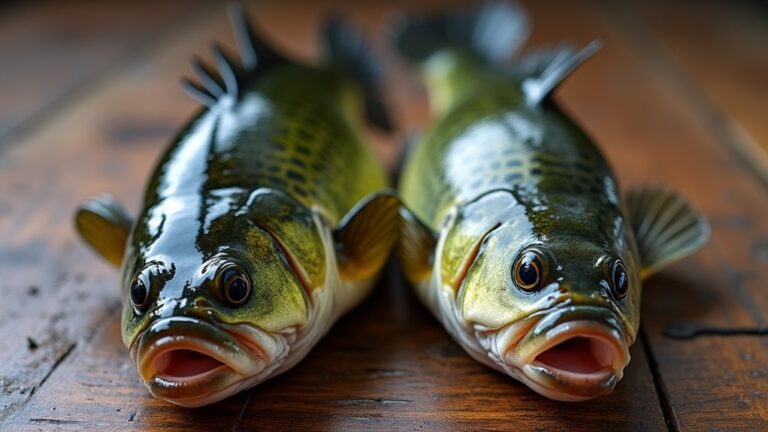To quickly identify saltwater fish, focus on three essential characteristics: body shape, coloration patterns, and fin structure. Body shape reveals adaptations to specific habitats and lifestyles. Coloration patterns can indicate camouflage strategies, warning signals, or mating displays. Fin structure and placement offer insights into swimming behavior and habitat preferences. You'll find that these features vary widely among species, from streamlined tuna to flat flounders. By observing these key traits, you'll become adept at recognizing different saltwater fish species. As you explore further, you'll discover how these characteristics interplay with size, habitat, and behavior to create unique identities for each fish.
Body Shape Variations
The diverse world of saltwater fish showcases an incredible array of body shapes, each adapted to suit specific habitats and lifestyles. When you're identifying saltwater fish, understanding these body shape variations is vital.
You'll find streamlined forms in pelagic species like tuna, which are built for efficiency in open water swimming. These sleek bodies allow them to cover vast distances with minimal energy expenditure, making them highly effective in their open ocean habitats, as highlighted in common saltwater fish types.
In contrast, you'll notice demersal fish such as flounder and halibut have flattened bodies. This adaptation helps them blend seamlessly with the ocean floor, evading predators and ambushing prey.
Reef fish, like the colorful clownfish, often display compact and deep bodies. This shape provides stability and maneuverability, important for guiding through the intricate structures of coral reefs.
Some species exhibit unique body shape variations. The pufferfish, for example, can inflate its body as a defense mechanism against predators.
You'll also find that body shapes can indicate feeding habits. Predatory fish like barracudas have elongated forms, perfect for swift strikes on their prey.
Coloration Patterns
While body shapes provide crucial clues for identification, coloration patterns in saltwater fish offer equally valuable insights. You'll find an incredible diversity of colors and patterns in the marine world, each serving a specific purpose. Bright, vibrant hues often act as warning signals, alerting predators to a fish's toxicity. The lionfish's striking red, white, and brown bands are a perfect example of this.
Additionally, some species, such as the Mahi-Mahi, showcase vibrant colors that not only attract mates but also help them blend in with their surroundings when necessary.
In contrast, some species use more subdued colors and intricate patterns for camouflage. Groupers, for instance, blend seamlessly with their surroundings. You'll be amazed by the adaptive coloration of creatures like octopuses, which can change their appearance rapidly to match their environment.
When identifying pelagic fish, look for countershading—a darker top and lighter bottom that helps them evade predators from multiple angles.
Don't overlook the importance of coloration patterns in fish behavior, either. Species like the zebra damselfish use their distinctive black and white stripes for mating displays and territorial disputes.
Fin Structure and Function

How do a fish's fins contribute to its unique identity and capabilities? When identifying saltwater fish, understanding fin structure and function is essential. You'll find that these aquatic creatures possess various fin types, each serving specific purposes in their daily lives.
The dorsal fin, located on the fish's back, helps maintain balance and prevents rolling during swimming.
You'll notice the caudal fin, or tail fin, propelling the fish forward. On the sides, pectoral fins enable precise movements and navigation through complex environments like reefs.
Underneath, pelvic fins assist in stabilizing and controlling movement, especially during slow swimming or hovering.
As you observe different species, you'll discover that fin structure can vary greatly. Some fish have elongated fins for display or increased surface area to enhance swimming efficiency.
These variations in fin shape, size, and position are key identifiers when distinguishing between species.
Distinctive Markings and Features
Beyond fin structure, a fish's distinctive markings and features play a key role in its identification. When you're trying to identify saltwater fish, pay close attention to their unique patterns and coloration. Distinctive markings like the vibrant orange bands of clownfish or the bold vertical stripes of zebra fish can help you quickly differentiate between species. Knowing about fishing species and habitats can further aid in recognizing where these fish are typically found.
Body shape is another vital characteristic to observe. You'll notice that some fish, like angelfish, have laterally compressed bodies, while others, such as triggerfish, are more robust and rounded. Look for unique features that stand out, such as the sailfish's elongated dorsal fin or the parrotfish's beak-like mouth.
Size can also be a telling factor in identification. You'll encounter a wide range of sizes in saltwater fish, from the tiny reef triggerfish measuring just 3.7-4.9 cm to the massive whale shark growing up to 12 meters long.
Don't forget to take behavioral traits into account as well. The territorial nature of damselfish or the schooling behavior of sardines can provide additional clues to help you identify specific saltwater fish species.
Size and Proportions

In saltwater fish identification, size and proportions play a essential role. You'll find an incredible range of sizes in saltwater species, from tiny reef triggerfish to enormous whale sharks. Understanding these variations can help you distinguish between similar-looking fish and even identify juveniles versus adults of the same species.
Size often influences habitat preferences. Smaller fish typically inhabit shallow reef areas, while larger species prefer open ocean environments. Proportions, such as body length to girth ratio, can vary markedly among species and affect their swimming efficiency.
Here's a quick reference table for some common saltwater fish:
| Species | Average Length | Distinctive Proportion |
|---|---|---|
| Reef Triggerfish | 3.7-4.9 cm | Small, compact body |
| Yellowfin Tuna | 1.5-2 m | Streamlined, torpedo-shaped |
| Wahoo | 1.5-2.5 m | Elongated, slim body |
| Sailfish | 3-3.4 m | Long, distinctive upper jaw |
| Whale Shark | Up to 12 m | Massive body, wide mouth |
When identifying saltwater fish, pay close attention to their size and proportions. These characteristics can provide valuable clues about the species, its age, and its typical habitat. Remember, specific size and proportion traits often contribute to a fish's unique appearance and can be essential in accurate identification.
Habitat-Specific Adaptations
Habitat-specific adaptations are critical for saltwater fish survival and identification. You'll notice these adaptations vary greatly depending on where the fish live. In open waters, pelagic species like tuna and wahoo have streamlined bodies, allowing them to swim efficiently.
On the ocean floor, demersal fish such as flounder and halibut have flattened bodies and camouflage coloration, helping them blend in with their surroundings.
Reef fish, including red snapper and gag grouper, often display vibrant colors and intricate patterns. These serve dual purposes: communication with other fish and camouflage in coral environments.
Many saltwater species have developed specialized sensory adaptations, like enhanced lateral lines, to detect vibrations and movements in their specific habitats.
Some fish, like the yellowfin tuna, have adapted to tolerate a wide range of salinity levels. This allows them to thrive in various oceanic environments, from coastal areas to the open sea.
When identifying saltwater fish, pay attention to these habitat-specific adaptations. They'll give you valuable clues about where the fish lives and how it behaves, making identification easier and more accurate.
Behavioral Traits

Behavioral traits play a crucial role in saltwater fish identification. When you're observing these creatures in their natural habitat, you'll notice various distinctive behaviors that can help you identify different species.
For instance, you might spot fish exhibiting shoaling behavior, forming dense schools for protection against predators. This is particularly common in species like sardines.
Another key behavioral trait to look out for is territoriality. You'll see fish like clownfish fiercely defending their anemone homes from intruders.
Additionally, pay attention to how fish communicate with each other using specific movements and fin displays, almost like an underwater sign language.
To further aid in identification, consider these three unique behavioral traits:
- Feeding habits: Watch for species like parrotfish using their beak-like teeth to scrape algae off coral.
- Migration patterns: Observe long-distance travelers like Atlantic salmon, which journey between freshwater and ocean habitats.
- Social interactions: Notice how fish use body language and movements to interact within their groups or with other species.
Geographical Distribution
Understanding where saltwater fish live is crucial for successful identification. The geographical distribution of saltwater fish spans various marine environments, from coastal waters to deep-sea habitats. You'll find approximately 15,000 identified species adapted to these regions, each with its unique characteristics.
To help you identify saltwater fish based on their geographical distribution, consider these key areas:
| Ocean | Region | Common Species |
|---|---|---|
| Atlantic | Coastal waters | Striped bass, Bluefish |
| Pacific | North Pacific | Pacific halibut |
| Indian | Tropical waters | Reef fish |
| Caribbean | Subtropical waters | Coral reef species |
Remember that tropical and subtropical waters, like the Caribbean Sea and Indian Ocean, host a rich diversity of saltwater fish. The Pacific Ocean is home to popular species such as king salmon and yellowfin tuna. Some fish, like the Pacific halibut, have specific geographical ranges, adapting to local environmental conditions.
Seasonal Changes in Appearance

Adaptation is key in the ever-changing marine environment, and saltwater fish are no exception. As you observe these aquatic creatures throughout the year, you'll notice remarkable seasonal changes in coloration. These transformations serve various purposes, from enhancing camouflage to attracting mates during breeding seasons.
To better understand these changes, consider the following:
- Breeding cycles: Male parrotfish display vibrant hues to attract females, while females become duller to blend in.
- Environmental factors: Water temperature and light availability influence pigmentation, aiding in thermoregulation and behavioral adaptations.
- Habitat shifts: Some species, like Atlantic salmon, undergo considerable morphological changes when moving between ocean and freshwater environments for spawning.
These seasonal changes can notably impact fish identification, especially during breeding periods when coloration may differ drastically from non-breeding times.
As you observe saltwater fish, keep in mind that their appearance can vary throughout the year. This knowledge will help you accurately identify species and understand their behavior in different seasons, enhancing your overall understanding of marine ecosystems.
Conclusion
You've now got the tools to identify saltwater fish like a pro. Remember, body shape, coloration, and fin structure are your key markers. Curiously, there are over 20,000 known species of marine fish, each with unique characteristics. As you explore the underwater world, keep your eyes peeled for distinctive markings and habitat-specific adaptations. With practice, you'll soon be naming fish faster than you can say "clownfish!"




